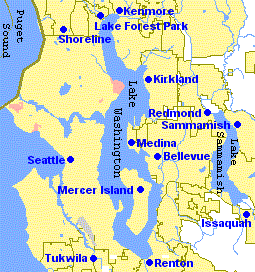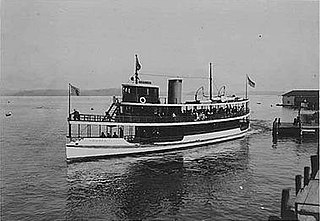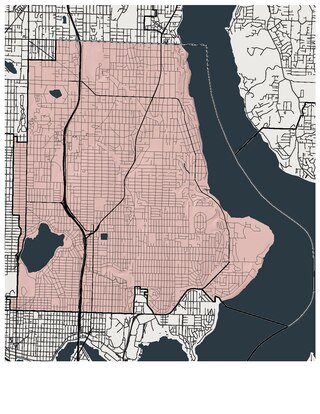
King County is located in the U.S. state of Washington. The population was 2,269,675 in the 2020 census, making it the most populous county in Washington, and the 13th-most populous in the United States. The county seat is Seattle, also the state's most populous city.

Haller Lake is a small lake and neighborhood in north central Seattle, Washington, named for Theodore N. Haller, who platted the neighborhood in 1905. His father, Granville O. Haller, was one of Seattle's early settlers, an army officer who amassed a large estate in the region.

The Eastside of the King County, Washington area in the United States is a collective term for the suburbs of Seattle located on the east side of Lake Washington.

Factoria is a mixed-use suburban neighborhood in south Bellevue, Washington and is one of the city's significant commercial districts. Originally timberland from the 1890s to 1920s and later envisioned as an industrial center, Factoria has since the 1960s evolved into commercial and residential development. Factoria was annexed into Bellevue in 1993. The core neighborhood is bounded by Interstate 90 to the north, Interstate 405 to the west, Newport Way to the east, and Coal Creek Parkway to the south.

The Third Lake Washington Bridge, officially the Homer M. Hadley Memorial Bridge, is a floating bridge in the Seattle metropolitan area of the U.S. state of Washington. It is one of the Interstate 90 floating bridges, carrying the westbound lanes of Interstate 90 across Lake Washington between Mercer Island and Seattle. The floating bridge is the fifth-longest of its kind in the world, at 5,811 feet.

The Bloedel Reserve is a 150-acre (0.6 km2) forest garden on Bainbridge Island, Washington, United States. It was created by Virginia and Prentice Bloedel, the vice-chairman of the lumber company MacMillan Bloedel Limited, under the influence of the conservation movement and Asian philosophy. The couple wished to capture the essence of the Japanese garden—the qualities of naturalness, subtlety, reverence, tranquility—and construct a Western expression of it. Although the Reserve includes a traditional Japanese garden, the Bloedels' approach for the rest of the property stands in contrast to that of 'Japanese gardens' which achieve their effects through the use of ornament. The Bloedel Reserve has both natural and highly landscaped lakes, immaculate lawns, woods, a stone garden, a moss garden, a rhododendron glen, and a reflection garden designed with the assistance of landscape architects Richard Haag, Thomas Church, Kazimir Wall, and Danielle Stern. The Bloedels' French Chateau-style home, including many original furnishings, is preserved as a visitor center.
Seacrest Cove 2 also known as Alki Cove 2 is a local dive site in West Seattle, Washington. The site within Seacrest Park is the most popular diving location in Seattle.

Area code 206 is a telephone area code in the North American Numbering Plan (NANP) for the U.S. state of Washington. The numbering plan area (NPA) includes Seattle and most of its innermost suburbs. This includes such suburbs as Shoreline and Lake Forest Park; Mercer, Bainbridge, and Vashon Islands; and portions of metropolitan Seattle from Des Moines to Woodway.

Frank B. Cooper Elementary School, usually called Cooper School, serves students from kindergarten through 5th grade. Located in the Pigeon Point neighborhood of Delridge, Seattle, Washington, it is part of the Seattle Public Schools district. The school's 14-acre (57,000 m2) site is immediately adjacent to the 182-acre (0.74 km2) West Duwamish Greenbelt, one of Seattle's largest wildlife habitat corridors. This rich natural environment enhances the school's environmental education program.
Underwater logging is the process of logging trees from underwater forests. When artificial reservoirs and dams are built, large areas of forest are often inundated; although the trees die, the wood is often preserved. The trees can then be felled using special underwater machinery and floated up to the surface. One such machine is the sawfish harvester. There is an ongoing debate to determine whether or not underwater logging is a sustainable practice and if it is more environmentally sustainable than traditional logging.
USS Curb (ARS-21) was a Diver-class rescue and salvage ship commissioned by the U.S. Navy during World War II. Her task was to come to the aid of stricken vessels.

The Seattle-Tacoma Shipbuilding Corporation was an American corporation which built escort carriers, destroyers, cargo ships and auxiliaries for the United States Navy and merchant marine during World War II in two yards in Puget Sound, Washington. It was the largest producer of destroyers (45) on the West Coast and the largest producer of escort carriers of various classes (56) of any United States yard active during World War II.

The steamboat Urania was a vessel that operated on Lake Washington and Puget Sound in the first part of the 20th century.
Cougar Mountain is a peak in the Issaquah Alps in King County, Washington. It is part of the highlands in the Eastside suburbs of Seattle, and at 1,614 feet (492 m) it is the lowest and westernmost of the Alps. About two-thirds of Cougar Mountain has experienced residential development, and is home to many neighborhood communities such as Lakemont. The forested heart of the hill was officially preserved by King County in June 1983 as Cougar Mountain Regional Wildland Park. Cougar Mountain is home to the Cougar Mountain Zoo.
The 1872 North Cascades earthquake occurred at in central Washington Territory. A maximum Mercalli intensity of VIII (Severe) was assessed for several locations, though less intense shaking was observed at many other locations in Washington, Oregon, and British Columbia. Some of these intermediate outlying areas reported V (Moderate) to VII shaking, but intensities as high as IV (Light) were reported as far distant as Idaho and Montana. Due to the remote location of the mainshock and a series of strong aftershocks, damage to structures was limited to a few cabins close to the areas of the highest intensity.

Washington's 46th legislative district is one of forty-nine districts in Washington state for representation in the state legislature. It includes the North Seattle neighborhoods east of Aurora Avenue except for the University District, as well as the cities of Lake Forest Park and Kenmore.
Sightly is an unincorporated community in Cowlitz County, Washington. Sightly is located east of the city of Castle Rock and east of Silver Lake. Sightly is reached by taking exit 49 off of Interstate 5, traveling 10.4 miles (16.7 km) east along Washington State Route 504, which is also known as the Spirit Lake Memorial Highway, and then traveling 2.4 miles (3.9 km) along Sightly Road. The Sightly community was given its name due to its views of Mount St. Helens. The Sightly community is part of the Toutle Lake School District, a K-12 school district of about 600 students.
Psi-ya-hus is a spirit rock near the Fauntleroy ferry terminal in Seattle, Washington. Coast Salish peoples associate the rock with A'yahos, a "malevolent and dangerous" spirit, capable of shapeshifting, who sometimes appears in a two-headed serpent form, who is associated with other earthquake-related areas like landslides near the Seattle Fault.
Florence Island is the main island formed by the diked river delta of the Stillaguamish River as it flows into Port Susan on Puget Sound.










